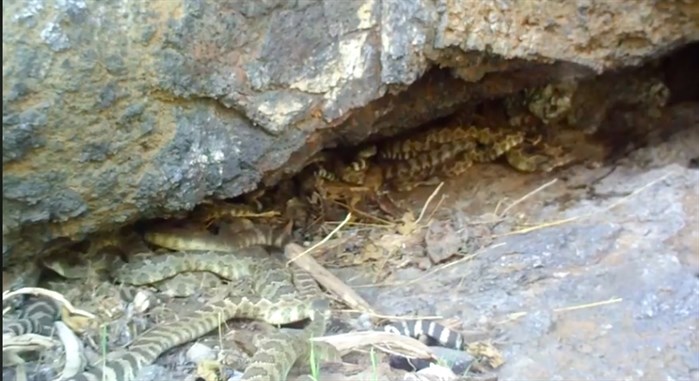
Extra caution is advised for those enjoying the outdoors as rattlesnake birthing season gets underway in the Thompson and Okanagan.
Image Credit: FACEBOOK/WildSafeB.C.
August 27, 2019 - 7:00 AM
PENTICTON - Hikers and trail users might want to use a little extra caution when enjoying the outdoors over the next few weeks as young rattlesnakes give birth to their young.
Young rattlesnakes may present an additional hazard as they are hard to distinguish from other snakes because they lack a rattle, instead having a modified scale called a button.
Wildsafe B.C. Provincial Coordinator Vanessa Isnardy says 30 to 40 per cent of adult rattlesnakes can have “dry” bites, where no venom is released, but young rattlesnake bites are almost always venomous because they have not developed the ability to control their own venom.
The Northern Pacific rattlesnake doesn't lay eggs. They are ovoviviparous- meaning they hold their eggs internally and then give birth to live young.
Isnardy says those travelling in rattlesnake country need to be aware of their surroundings and watch their step. Go around rock piles rather than stepping over them.
Dogs should be kept leashed, as their inquisitive nature could get them into trouble.
If you hear a snake, stop immediately and locate the snake. If it is close, wait until the snake calms down and retreats before stepping back.
Rattlesnakes are generally shy and non-aggressive, a most common mode of defence being to lie still and use their camouflage to remain undetected.
While rattlesnake bites are rare and generally not fatal, the best treatment for being bitten is to remain calm and head for the nearest hospital. Don’t use a tourniquet or make an incision to try to suck out the venom.
Dogs that suffer a rattlesnake bite should be taken to the nearest emergency veterinarian clinic.
The Northern Pacific Rattlesnake can be found throughout the Okanagan and Thompson regions.
Rattlesnakes mate around this time of year, from August into October, but pregnant female rattlesnakes don’t give birth until mid-September to October the following year.
Once pregnant, the female rattlesnake can go over a year without eating.
Rattlesnakes in B.C. are protected under the wildlife act and it is illegal to injure, kill or capture them.
For more information on rattlesnakes, see the Wildsafe BC website.
To contact a reporter for this story, email Steve Arstad or call 250-488-3065 or email the editor. You can also submit photos, videos or news tips to the newsroom and be entered to win a monthly prize draw.
We welcome your comments and opinions on our stories but play nice. We won't censor or delete comments unless they contain off-topic statements or links, unnecessary vulgarity, false facts, spam or obviously fake profiles. If you have any concerns about what you see in comments, email the editor in the link above.
News from © iNFOnews, 2019